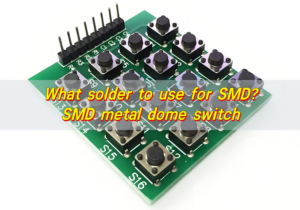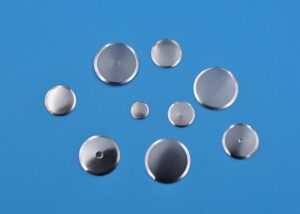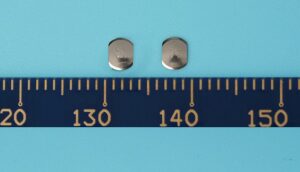Metal dome array, or snap dome switch, is a tactile interface component used in devices like remotes, keyboards, and medical tools. These stainless steel domes sit on a circuit board, forming a grid that closes an electrical circuit when pressed. A crisp snap and instant feedback users feel and hear.
Compact, durable, and designed for millions of presses, these switches balance reliability with affordability. They’re ideal for slim, spill-resistant designs and outperform bulkier mechanical switches in cost and space efficiency.
How does a snap dome switch work?
The spring switch is not just a metal disc, but a precision-formed spring that makes a “snap” sound when pressed. That snap is what gives the crisp, tactile response.
Inside the switch, the metal dome rests above a circuit. When you press down, the dome collapses, creating contact with the circuit beneath it. This completes the electrical connection. Release the dome, and it pops back to its original shape, ending the signal.
That popping action is quick, clean, and dependable. It’s why devices that use metal dome arrays feel so responsive. It’s more than just a physical sensation—it gives users confidence in their press, which is crucial for industrial, medical, or consumer interfaces.
What’s the difference between a single and double metal dome array?
Not all dome arrays are created equal. There are two major types: single metal dome arrays and double metal dome arrays.
A single metal dome array includes one dome per button. It’s the standard for basic applications—simple, effective, and low-profile. But when performance and enhanced feedback matter more, the double metal dome array steps in.
This double metal dome array places two domes—one inside the other or stacked—to create stronger tactile feedback. It improves actuation strength and helps prevent accidental presses. This layered setup delivers a firmer, more deliberate feel.
What does a double metal dome array switch do?
The double metal dome array switch adds muscle to precision. It’s built for environments where false triggers can’t happen—think medical instruments, military-grade devices, or rugged outdoor equipment.
Each press on a double dome switch feels more prominent. That’s by design. The outer dome offers a soft press, while the inner dome gives the satisfying snap. This two-layer response reduces wear, increases lifespan, and boosts confidence for the user.
The double structure supports repeated use, making it ideal for heavy-duty applications. Over time, this means fewer failures, more productivity, and better user satisfaction.
Where are metal domes commonly used?
Metal domes are everywhere—but quietly so. You’ll find them in remote controls, calculators, medical devices, industrial panels, and even smartphones.
From ATMs to elevators, from hospital monitors to handheld terminals—metal dome arrays play a crucial role. Designers rely on them not just for feedback, but for precision and durability.
In the electronics world, space is often limited. Metal domes are compact and reliable, making them ideal for confined spaces.
How is a metal dome array different from rubber domes?
At first glance, metal domes and rubber domes might look similar. Both provide tactile feedback. But they feel—and function—very differently.
Rubber domes are softer. They use silicone material to provide a press. While that can be gentle, it’s often vague. Users may struggle to feel if a press was successful.
Metal domes, by contrast, offer a sharper, cleaner tactile response. The click is unmistakable. They don’t just press—they snap. That snap ensures the signal is received.
Also, rubber domes wear out faster. Silicone deforms over time. Metal domes are built to last, keeping their shape and function far longer.
How does a metal dome array improve tactile feedback?
Tactile feedback isn’t just about comfort—it’s about communication. A clear, positive click tells the user: “Your input was received.”
This is where metal dome arrays shine. Their construction offers consistent resistance followed by a quick release. That sudden change is what your fingers recognize as feedback. It’s the snap you feel in every press.
Compared to mushy alternatives, the dome array gives a precise actuation point. There’s no guessing. In a fast-paced or high-stakes environment, this tactile assurance is vital. It removes uncertainty.
What’s the function of a metal dome in a keypad?
The metal dome is the hero behind every keypad press. Its job is simple: create an electrical contact when pressed.
Each dome acts like a tiny spring. Press it, and it collapses. Release it, and it snaps back. During that collapse, it touches a conductive trace on the circuit board, closing the loop and sending a signal.
But it’s not just about function. The dome also shapes how the button feels. Customizing the dome’s shape, size, and material changes the feel entirely.
What’s the role of a dome array in membrane switch technology?
In membrane switch technology, every layer matters. But the dome array is where the action happens. It bridges the gap between user and circuit.
The dome array sits between the graphic overlay and the printed circuit. When pressed, the dome makes contact with the lower circuit layer, sending the input. This layer not only handles the mechanical movement but enhances tactile feedback and improves switch lifespan.
Without the dome array, membrane switches would feel flat and dull. Users wouldn’t know when or if a button worked. That tactile snap is what makes the interaction satisfying and reliable.
Also, dome arrays can be easily customized. Shape, size, and force level can all be adjusted to meet the needs of a specific application. Whether it’s light-touch for touch-sensitive applications or a strong press for industrial use, dome arrays make it possible.
Conclusion:
Metal dome array isn’t just a component—it’s the heartbeat of a reliable, user-friendly interface. From snap dome switches to double dome arrays, these tiny domes deliver powerful results.
If you’re designing a product where performance, feedback, and reliability matter—metal dome arrays are your best ally.
Want to know more or get a custom solution for your keypad design? Reach out to us at sales@metal-domes.com














